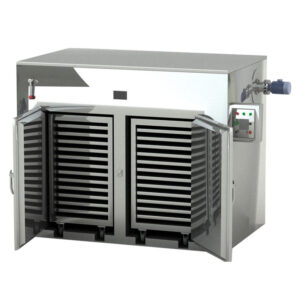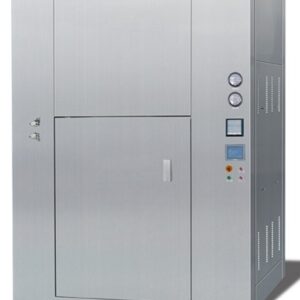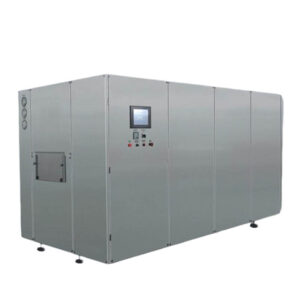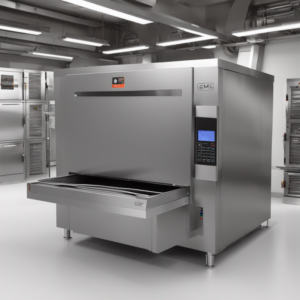Sterilizing Oven
The ultimate solution for perfection in cleanliness is the Qualipak Sterilizing Oven. It has advanced technology and precise control that ensures you get rid of any germs in your products without tampering with their quality. We have a dependable sterilizing oven for improved sanitation standards. For quality and reliability, choose Qualipak. Every cycle gives you peace of mind.
Introduction of Pharmaceutical Sterilizing Oven
In the pharmaceutical industry, there is a great need to maintain sterile conditions for the safety and effectiveness of drugs and medical devices. When it comes to drug manufacturing, pharmaceutical sterilizing ovens are important as they provide a way of sterilising equipment, containers, and materials used among others. This guide provides information on various perspectives of pharmaceutical sterilizing ovens such as types, working processes, applications, functions, benefits, future trends as well as maintenance and training.
Types of Pharmaceutical Sterilizing Ovens
- Several types of pharmaceutical sterilizing ovens are available depending on the application or requirement needed. The following are some common ones:
-
Dry Heat Sterilizers
- This type makes use of high temperatures to destroy microorganisms. It usually operates at temperatures within the range of 160°C to 180°C. Although dry heat penetrates slowly through materials but very effective in dealing with heat-stable items such as powders and metal instruments or glasses. It is suitable for substances that can be damaged by moisture or steam.
-
Steam Sterilizers (Autoclaves)
- Sterilization using pressurized steam takes place in a steam sterilizer also known as an autoclave that functions at temperatures between 121°C-134°C killing off a wide range of microorganisms including bacteria fungi viruses etc.. Autoclaves are often used for sterilizing liquids, glassware surgical instruments laboratory ware.
-
Depyrogenation Ovens
- Depyrogenation ovens have been designed specifically to remove pyrogens which are fever-inducing substances released by certain bacteria. Such ovens use high heat levels typically exceeding 250°C to decompose and remove pyrogens from vials glass and other heat-resistant materials commonly employed in the manufacture of drugs.
-
Forced Air Sterilizers
- Sterilization via forced air requires hot air that is moved across by fans for it to be achieved in this type. This technique is highly suitable for sterilizing materials that are sensitive to moisture or pressure, such as oils, powders and heat-sensitive things related to healthcare. Forced air sterilizers have faster cycle times as compared to other methods which make them efficient in mass production.
Working Processes of Sterilizing Ovens
- The working processes of pharmaceutical sterilizing ovens usually depend on the type of method of sterilization being used. However, they generally follow these basic steps:
- Preparation: When preparing for sterilization, items that are placed inside the chamber must be spaced out well enough to allow some amount of penetration by either heat or steam.
- Heating: The temperature required for sterility is reached after heating the sterilizing chamber. In dry heat, it’s hot air that permeates the whole chamber while steam sterilizers produce steam under pressure.
- Sterilization: Once desired temperatures and pressures have been achieved, then the process of sterility begins. On their surfaces, the organisms get killed or denatured by heat or steam.
- Cooling: Gradually reduce the chamber’s temperature after sterilization to prevent thermal shock on items being sterilized.
- Exhaust: To open the door, any excess steam in a steam steriliser should be vented out first from the chamber.
Unloading: This occurs once there is sufficient cooling down in case of a complete cycle of sterilization and completion; thus all sterile objects come outside from the oven again.
Applications of Pharmaceutical Sterilizing Ovens
- Pharmaceutical manufacturing firms across various sectors use pharmaceutical sterilizing ovens in many different ways including:
- Manufacturing: These ovens provide an effective means through which equipment containers raw materials etc., can be subjected to extreme conditions before drugs are made thereby avoiding contamination during drug manufacturing
- Quality Control Laboratories: Glassware media etc., used for microbiological testing and research purposes are subjected to this oven where it ensures they become safe for use.
- Packaging: Sterilization of packaging materials such as bottles, vials, and blister packs is done using sterilizing ovens to keep them sterile during product packaging.
- Research and Development: Experimenting with new concepts in R&D laboratories necessitates the use of sterilizing ovens for sterilization of laboratory equipment, culture media, and experimental materials to ensure accuracy.
Hospital and Healthcare Facilities: In hospitals as well as healthcare centres autoclaves are used extensively to sterilize surgical instruments, medical devices, and linens.
Functions and Benefits of Pharmaceutical Sterilizing Ovens
- Pharmaceutical sterilizing ovens perform multiple vital roles and provide many advantages such as;
-
Functions
- Disinfection: Sterilization ovens operate by wiping out bacteria, viruses, fungi or yeast from materials so that no contamination occurs.
- Depyrogenation: Pyrogens are fever-causing substances targeted specifically by depyrogenation ovens so that pharmaceutical products remain pyrogen-free.
- Retention of Sterile Conditions: From research elements to items ready for consumption besides finished products; the role of sterilizing ovens is to ensure sterile conditions are maintained during pharmaceutical manufacturing procedures.
- Ensuring Product Safety: By eliminating microbial contaminants then sterilizing the oven contributes towards the safety and efficacy of pharmaceuticals thereby lowering the chances of infection or adverse reactions in patients.
-
Benefits
- Versatility: The versatility of these pharmaceutical machines enables them to accommodate different kinds of materials which may include glassware, metallic tools plus liquids among others.
- Efficiency: With rapid cycle times available for these purposes, this kind offers fast processing rates for large volumes within a relatively short time frame compared to other types
- Cost-Effectiveness: Investment in sterilizing ovens is worth it due to a reduction in costs by minimizing disposable material expenses while guarding against product recalls arising from contamination issues faced by some enterprises developing drugs.
- Compliance: Concerning quality standards 0and regulatory requirements pharmacological manufacturers should adhere to while making their products safe enough for human use therapeutic agents including the ones listed above should at least be subjected through these environments where heat treatment happens hence resulting in the removal of all pyrogenic substances.
Reliability: State-of-the-art sterilizing ovens include advanced features and controls that make sure that the same level of sterility is retained throughout many batches.
Future Trends in Pharmaceutical Sterilizing Ovens
- The pharmaceutical industry is constantly changing as a result of technological advancements as well as variations in regulatory policies. The following are several trends influencing the future of pharmaceutical sterilizing ovens:
- Automation and Integration: There is an increasing demand for ovens used for sterilization purposes to be automated and integrated seamlessly with other processes within the pharmaceutical sector like in some biotech industries. Automation serves to eliminate human errors which may result in different outcomes.
- Validation and Compliance: This compels manufacturers to develop equipment that puts more emphasis on validation and compliance needs during the sterilization process, including new monitoring systems or software, etc. Future devices will have sophisticated monitoring mechanisms coupled with documentation systems enabling easy validation procedures.
- Energy Efficiency: Manufacturers are designing safe, reliable, compact, energy-efficient devices that can cut down on running costs while minimizing damage to the environment by using such methods as the incorporation of energy-saving heaters, better insulation materials, and cycle optimization techniques among others.
- Innovative Sterilization Technologies: Researchers are investigating alternative methods of sterilization like microwave sterilization, plasma sterilization and ultraviolet (UV) sterilization instead so that these other ways can be quickly implemented due to their speediness, effectiveness or compatibility with heat-labile items such as drugs
Real-Time Monitoring and Control: Upcoming sterilizers will come equipped with sensors plus monitoring systems that offer real-time monitoring for temperature, pressure level rates or time taken when undergoing this procedure; hence accurate control can be achieved leading to optimal efficiency while assuring good quality products at last.
Maintenance and Training
-
Maintenance
- Regular Inspection and Cleaning: Regular scheduled inspections should be conducted on a timely basis to ensure cleanliness particularly when the sterilizing oven is clogged by dirt or other matter which may affect its performance or contaminate products.
- Calibration and Validation: Regular calibration of temperature, pressure, and other critical parameters is essential to maintain the accuracy and effectiveness of the sterilization process. In addition, validation studies should be done to determine whether the sterilization cycle has been effective enough.
- Preventive Maintenance: Making a preventive maintenance schedule ensures potential problems are detected and corrected before they become expensive breakdowns or failures. These include routine checks of components like heating elements, seals and sensors.
- Replacement of Consumable Parts: It is advisable to replace consumable parts such as gaskets, filters and seals as recommended by the manufacturer for optimum performance and to prevent leaks or contamination.
- Documentation and Record-Keeping: Detailed records of maintenance activities including inspections, repairs and calibrations should be kept so that they could be traced in future which is important for compliance with regulatory requirements.
-
Training
- Operator Training: Operators responsible for operating the sterilizing oven should receive adequate training on its functions, operational procedures, safety measures, troubleshooting techniques etc.
- Validation Training: Personnel involved in validation activities should undergo training on validation protocols, data collection techniques, and statistical analysis among others that will ensure their compliance with regulatory requirements.
- Safety Training: To avoid accidents, injuries or exposure to hazardous chemicals associated with running or maintaining sterilizing ovens it is important to train personnel on safety protocols and procedures.
- Quality Assurance Training: To ensure product quality and regulatory standards compliances quality assurance staff need training on quality management systems, standards put forth by regulators as well as documentation requirements that pertain to this field.
- Emergency Response Training: This means equipping employees with emergency response procedures including how to respond during equipment failure or leaks among other emergencies so that these risks can be minimized while still ensuring the safety of both people working there as well as products getting processed there.
- Continuing Education: In addition, personnel require continuous training programs on professional development so that they can keep abreast with technological advancements in sterilization; regulatory changes regarding sterilization procedures; best practices in maintenance & operation; etc.
- Cross-Training: Cross-training staff members into different roles within the Sterilization process provides redundancy and flexibility in staffing levels thus reducing the risk of disruptions caused by employee turnover or absenteeism.
- Supplier Training: On the other hand, suppliers of equipment should train the users on various features, operation and maintenance requirements of a sterilizing oven since they are familiar with it.
- Documentation Training: Those responsible for documentation and record-keeping must be trained in proper documentation practices, data integrity as well as compliance issues with regulatory requirements to ensure accurate and complete records are maintained.
Auditing and Compliance Training: By ensuring that the sterilizing oven meets regulatory standards and quality requirements, personnel will be prepared for internal and external audits through training on auditing procedures as well as compliance requirements.
FAQs
- 1. What is a pharmaceutical sterilizing oven?
- A pharmaceutical sterilizing oven is a piece of special equipment used in pharmaceutical production to remove all microorganisms from equipment, materials, or packaging by using dry heat, steam or other means of sterilization.
- 2. How does a pharmaceutical sterilizing oven work?
- Pharmaceutical sterilizing ovens can either heat materials at high temperatures; use steam under pressure or employ another variety of methods such as ethylene oxide gas or ionizing radiation to kill microorganisms before achieving sterility depending on their type.
- 3. What are the different types of pharmaceutical sterilizing ovens?
- The basic kinds of such ovens include dry heat sterilizers, moist heat autoclaves (autoclaves), Ethylene Oxide (EO) Sterilizers and Radiation Sterilizers among others.
- 4. What materials can be sterilized using pharmaceutical sterilizing ovens?
- Among many other things glassware, metal instruments, plastic wares & components made from rubbers; packaging materials etc are some examples that may be mentioned here in this connection which could be done through these processes.
- 5. What are the applications of pharmaceutical sterilizing ovens?
- Pharmaceutical sterilizing ovens are used in pharmaceutical manufacturing, research laboratories, hospitals, clinics, pharmaceutical packaging facilities and sterile compounding pharmacies to ensure the sterility of products, equipment and materials.
- 6. How often should a pharmaceutical sterilizing oven be maintained?
- To maintain optimal performance and comply with regulatory standards such as Good Manufacturing Practices (GMP), Pharmacopeial standards and international guidelines for product quality, safety and regulatory approval; it is necessary to perform regular preventive maintenance on pharmaceutical sterilizing ovens by manufacturers’ recommendations including inspections, calibrations and replacement of consumable parts.
- 7. What training is required for operating a pharmaceutical sterilizing oven?
- For the safe operation of the machine, any operator has to receive training about its functions, operating procedures, safety precautions and troubleshooting techniques.
- 8. How long does it take to sterilize materials using a pharmaceutical sterilizing oven?
- Sterilization cycles can range from minutes to hours depending on factors such as the type of sterilizing agent used, load size and material being sterilized.
- 9. Are pharmaceutical sterilizing ovens environmentally friendly?
- Eco-friendly dry heat or radiation-based pharma sterilizers are available that do away with the use of water chemicals or disposable non-reusable items.
- 10. What regulatory standards apply to pharmaceutical sterilizing ovens?
- Such regulations that these kinds of devices must follow include good manufacturing practices (GMPs), pharmacopeial standards as well as internationally agreed rules meant to ensure quality products.




